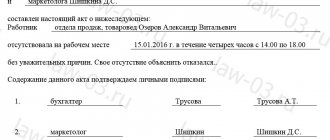There is no unified, specially developed sample order for disciplinary action. Organizations can independently develop an order template or write it in free form. To write an order, you can use the organization’s letterhead or a regular A4 sheet. The law allows the writing of a disciplinary order either by hand or in printed form, but the original signatures of the director of the organization, as well as the offending employee, must be present on it.
- Form and sample
- Free download
- Online viewing
- Expert tested
FILES
What is a reprimand and what does it mean for an employee?
A reprimand is one of the most common types of disciplinary action (read the order on disciplinary action) and is the mildest punishment. Typically, the employer resorts to precisely this measure of influence when he wants to warn the employee about the inadmissibility of such violations in the future.
The remark does not have to be included in the employee’s personal file, but sometimes employers do so. In addition, the remark may be accompanied by such an action as the cancellation of bonus payments (if this type of incentive is provided for in the employee’s employment contract).
What can you be punished for?
Disciplinary punishment is applied as a response to a disciplinary offense committed by an employee, which is Art. 192 of the Labor Code of the Russian Federation defines it as “non-fulfillment or improper fulfillment by an employee, through his fault, of the labor duties assigned to him.” In other words, any violation of an employee’s obligations set forth in an employment contract, job description or local regulations adopted by the organization can be considered a misdemeanor. The most common offenses are:
- violation of work schedule (lateness, absenteeism, premature departure from work);
- reporting to work in an altered state of consciousness (under the influence of alcohol, drugs and other substances);
- failure to comply with direct instructions from management;
- neglect of labor safety rules;
- inconsistency of work results with fixed quality criteria.
In fact, each company has its own list of typical violations, determined by its specifics.
How long does a remark last?
After an employer has reprimanded his subordinate, the latter must keep in mind that for a year after that he will be under close supervision.
If during this period there are no repeated violations, then the remark will be automatically canceled and all the employee’s rights will be restored in full, but if something similar happens again, the offender may be punished more severely: with a reprimand or even dismissal.
It should be noted that the employer has the right to early cancel a disciplinary sanction previously applied to an employee. This is quite simple to do: you just need to issue the appropriate order to cancel the order and familiarize the responsible persons with it, as well as the employee himself. Typically, the reason for canceling a penalty is repentance, clear signs of correction by the employee, strict adherence to labor discipline and excellent work performance.
Answers to frequently asked questions
Question No. 1: Can an employee be fired if he absents himself once? Until now he had no penalties.
If absenteeism is primary and the employee is responsible for his work, then no. Usually in this case a reprimand is issued.
Question No. 2: Can an employee be punished for violation of discipline (dismissed) if he was absent for a long time due to delays in public transport or due to weather conditions?
The reasons listed are valid. Deputy The head of Rostrud, Ivan Shklovets, noted that being late for work due to unfavorable weather conditions (blizzard, snowfall, etc.) is not a misdemeanor. Accordingly, punishment for violation of discipline is not applied here.
But an employee will not be fired only if this fact actually occurred and (for example, a flight delay) is documented.
Basis for the order
Absolutely any order drawn up on behalf of the company’s management must have a written basis. In most cases, this is
- a memorandum or memo from the head of the structural unit in which the offending employee works,
- as well as an act recording the offense and an explanatory note.
Without these papers, the document will not be considered justified and in which case it will be very easy to refute it; moreover, for the lack of a basis for writing the order, and therefore the penalty itself, the employer may be subject to administrative punishment.
Results
The employer has the right to punish a negligent employee for labor misconduct. It is important to fully understand his circumstances and complete all documents correctly so that the consequences of disciplinary action do not become the subject of legal proceedings. Among such documents is an order for disciplinary action, a sample of which is posted on our website.
Sources: Labor Code of the Russian Federation
You can find more complete information on the topic in ConsultantPlus. Free trial access to the system for 2 days.
Procedure for announcing a comment
Before reprimanding an employee, the employer is required by law to first record the violation itself (for this purpose, a special act details the essence of what happened, the date and time of the event), and then receive an explanation from the employee regarding the fact of the violation.
Explanations must be given in no more than two working days - if they are not there, it is considered that the employee does not have valid reasons to justify the offense committed.
If there are explanations, but the employer did not consider them weighty enough (and this opinion is confirmed by the law), this also serves as a basis for disciplinary action.
Next, an order is drawn up, which assigns a penalty in the form of a reprimand.
If the offender does not want to sign the document, a corresponding act should be drawn up about this.
The employee in respect of whom the order was issued must be familiarized with it within three days against signature, as well as those employees of the enterprise who are responsible for the implementation of this order.
The procedure for imposing a disciplinary sanction should be treated very carefully, because if the matter comes to proceedings in the labor inspectorate or court, the entire process and every piece of paper in it will be examined “under a microscope.”
Typical mistakes when applying punishment in the form of dismissal for absenteeism
| Erroneous actions on the part of the employer | Correct solution |
| The employee is subject to a disciplinary sanction that has expired | The norms of Art. 193 of the Labor Code of the Russian Federation, prescribing the procedure for dismissal for guilty actions. The terms of application of punishment were violated. The employer has the right to apply a penalty no later than one month from the date of its discovery. |
| The director of the branch was fired for a single gross violation of labor duties (Clause 10, Article 81 of the Labor Code of the Russian Federation). The dismissed branch director went to court, claiming that he had not committed any violations | Again, the dismissal procedure was violated. To dismiss the director of a branch on this basis, a documented evidence base is required. There are no recorded specific facts proving the manager’s guilt. Therefore, this dismissal is illegal. The manager should legally be reinstated to his previous place of work |
Explanations of Rostrud on the issue of correct execution of an order for recovery in the form of dismissal (letter No. 1493-6-1 dated 06/01/2011)
We hereby inform you that for a disciplinary offense, a penalty will be imposed on the guilty employee: a reprimand, a reprimand, or dismissal for proper reasons. In all cases, an order is issued.
Penalty - dismissal is formalized by order using the standard T-8 form. In this case, the line “Grounds” records acts of absence of the dismissed person from the workplace, explanatory notes of the offender, and reports of the manager. It's enough. In addition to it, another order to impose a penalty is not needed.
It is noted that some organizations practice the simultaneous issuance of two orders. One is on the application of penalties, the second is on the termination of an employment agreement (T-8 format). According to Rostrud, this fact is not a violation of the norms of the Labor Code of the Russian Federation.
The document was compiled by the head of the legal department A.V. Anokhin.
Example 1. Procedure for applying punishment for long absence
An employee of Stroyka LLC, S.R. Novichenko, was absent from work for a long time, without telling anyone anything. No one knew where she was. It was impossible to contact her. As a result, the manager drew up an act of absence of S. R. Novichenko from work.
When the employee showed up at work, the head of the department called her and demanded that she write an explanatory note. Since the employee did not provide any reasoned explanations, the management decided to take disciplinary action against her - dismissal under Article 81 of the Labor Code of the Russian Federation for absenteeism without good reason. The procedure was carried out in the following order:
- Drawing up a memo by the head of the department about the absence of S. R. Novichenko from work.
- Submission of a report, an act on the employee’s absence from work, an explanatory note from S. R. Novichenko to the head of the organization in order to inform about what happened and to take corrective action against this employee.
- Issuance and registration of an order (T-8 format) on dismissal for absenteeism.
- Familiarization of the dismissed employee with the order against her signature.
- Calculation, issuance of a work report with a note of dismissal with reference to paragraph “a”, paragraph 6 of Art. 81 Labor Code of the Russian Federation.
In the calculation, the accounting department included: unpaid wages at the time of dismissal and compensation for unused regular vacation.
Rules for drawing up an order
Today there is no unified sample order for disciplinary action, so employers can write it in any form or according to a template developed within the enterprise. In this case, it is necessary that this document contain a number of certain information, including:
- name of company,
- Document Number,
- the date and place of its preparation,
- personal data about the offending employee (his position and full name).
The order must indicate the reason for its creation (i.e., indicate the essence of the complaint against the employee), the date of the offense, and also provide references to the basis. The latter are usually an act recording the violation and a report or official note from the head of the offender and an explanatory note (if any).
Types of penalties
In practice, an employer often shows amazing ingenuity when imposing sanctions on an offending employee. However, at the legislative level there are only three types of punishment: reprimand, reprimand and dismissal on appropriate grounds (Article 192 of the Labor Code of the Russian Federation). This means that the use of methods such as deprivation of bonuses, fines, etc. is unlawful. The employer's freedom in this case is limited to independently assessing the severity of the violation and choosing a response method from the three options proposed by law. Obviously, the most serious measure is dismissal for appropriate reasons. If we talk about a remark and a reprimand, the law does not explain their differences, nor does it provide clear definitions of these concepts. It is generally accepted that a reprimand is more severe in nature compared to a reprimand.
Rules for placing an order
The order can be drawn up in different versions: both in handwritten format and in printed form, both on a simple A4 sheet and on the company’s letterhead. However, he must have the original autograph of the director of the company or a person authorized to sign such papers. It is not necessary to endorse it using a seal, since it relates to the internal administrative documentation of the company; moreover, since 2016, legal entities are exempt from the need to certify their documentation using seals and stamps.
Instructions for writing a disciplinary order
- At the beginning of the document, the full name of the legal entity is written, indicating its organizational and legal form (CJSC, OJSC, LLC, individual entrepreneur). Then the word “Order” is written, its number according to internal document flow is indicated and the essence of the document is briefly indicated.
- In the line below you should enter the locality in which the organization is located, as well as the date the order was filled out (day, month (in words), year).
- Next, you need to provide detailed information about the essence of the claim against the employee, in other words, the reason for imposing the penalty. Here you should enter his last name and first name. patronymic (first name and patronymic can be in the form of initials), date of the identified violation.
- After this, you need to enter the word “I order” and enter the appropriate order (to reprimand, make a reprimand or dismiss the employee). Below are the reasons for issuing the order (memorandum, explanatory note, act, etc.).
- Finally, the order must be signed by the management team: the director of the enterprise, the head of the structural unit, the person responsible for personnel. The offending employee must also sign the order.
If desired, the order can be certified with a seal, but starting from 2021, legal entities do not have to have a seal. If the enterprise has a trade union body, then it must also be marked.






